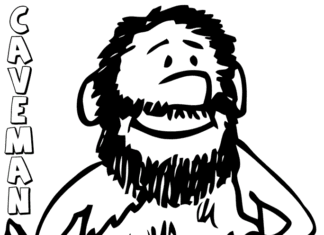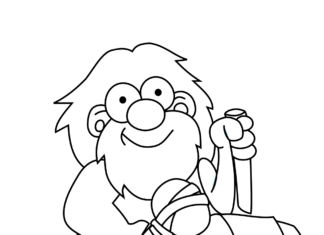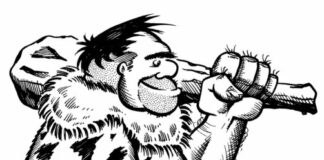Cave man is a term used to describe the ancient people who inhabited caves and other natural shelters in the prehistoric period.
Coloring Book Caveman
information
- Prehistoric period: Cavemen were people who lived in the prehistoric period, that is, before the invention of writing and the appearance of recorded historical sources. Their lives were not recorded in writing, so information about them comes mainly from archaeological research.
- Mode of life: Cave dwellers lived a nomadic lifestyle, moving between different shelters depending on the seasons and the availability of food. Caves and other natural rock formations served them as shelters from extreme weather and wild animals.
- Tools: Cavemen used tools made of stone, bone, wood and other available materials. These tools helped them hunt, make clothing and other items.
- Art and Symbolism: Cavemen are known for creating cave art. They painted drawings depicting animals, people and abstract designs on cave walls. They often used natural dyes such as ocra and charcoal.
- Community: Cavemen lived in family groups or small communities. They worked together to hunt, gather food and defend themselves from threats.
- Evolution: Cavemen are one of the evolutionary links leading to modern humans. Their lifestyle and survival skills contributed to the survival of the species under harsh prehistoric conditions.
- Archaeological discoveries: Archaeological studies of cave settlements and finds provide information on the tools, ornaments, art and daily life of ancient people.
- Relationships with wildlife: Cavemen lived close to nature and depended on capturing animals for meat, skins and bones. They may have had some form of symbiosis or interaction with some animals.
- Fire and lighting: The campfire was central to the lives of cavemen. It was used to cook food, keep them warm and ward off wild animals. Lighting provided them with a source of warmth and safety in the dark.
- Cultural Evolution: The cavers were able to transmit knowledge and skills through oral messages and drawings on cave walls. In this way, they passed on information about hunting, medicinal plants and other aspects of life.
trivia
- Cave art: Cave-dwellers are known for creating cave paintings and sculptures, which are discovered in caves around the world. The most famous example is Lascaux in France, where there are beautiful prehistoric paintings.
- Musical instruments: Archaeologists have found evidence suggesting that cavemen may have made simple musical instruments, such as flutes from bones or drums from wild skins. This may indicate the first attempts at making music.
- Clothing and ornaments: The cavemen probably wore clothing made of animal furs, skins and leaves. They also created ornaments such as necklaces made of bones or shells, suggesting an evolving concept of aesthetics.
- Prehistoric Cuisine: Although recipes have not survived, archaeologists speculate that cavemen consumed a variety of foods, including meat, fish, fruits, nuts and roots.
- Variety of tools: Cavemen were skillful craftsmen, creating a variety of tools such as axes, knives, arrows and spears. Some tools may have had specialized uses, such as in hunting.
- The meaning of fire: Fire was extremely important to cavemen. It was used not only for cooking, but also as a source of heat and illumination in the darkness of the cave.
- Simple Technologies: Cavemen developed technologies for everyday life. For example, they used stones to grind grains or wood to create simple tools.
- Adaptation to the environment: Cavemen adapted to different geographic conditions. Those living in Arctic areas were able to create igloos, while those living in warmer regions used natural rock shelters.
- Differences in burials: Archaeological findings suggest that cavemen had different burial customs, depending on region and culture. Some finds indicate symbolic burials, suggesting the beginnings of a primitive belief in an afterlife.
- Evolution of the human species: Cavemen are one link in the long evolutionary line leading to modern humans. Their ability to survive in harsh conditions contributed to the evolutionary success of Homo sapiens.
- Cultural impact: Modern culture still refers to the image of cavemen as primitive people, which translates into movies, books, art and comics.
- The discoveries are still ongoing: Archaeologists continue to conduct research and uncover new information about the cavemen, uncovering their lives, customs and technologies.








